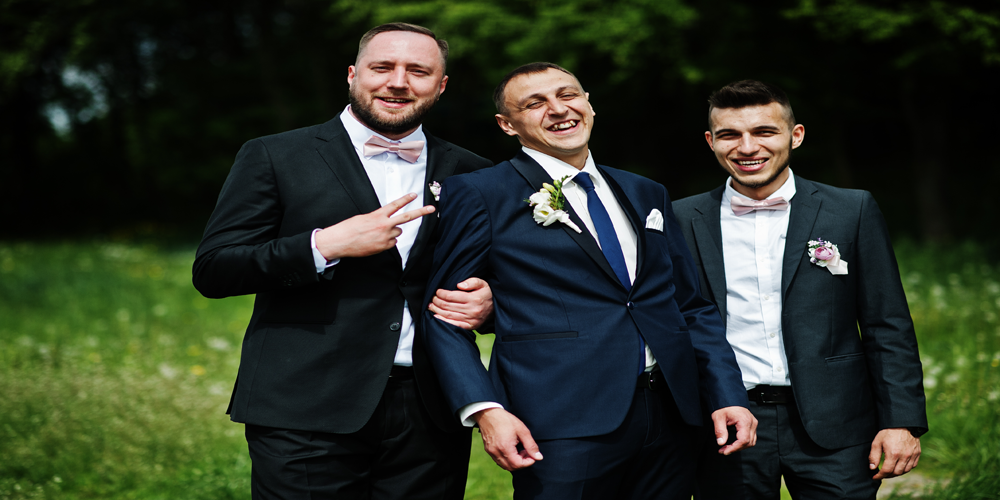Buying Your Wedding Suit: A Groom’s Handbook
Congratulations, you’re getting married! As you embark on this exciting journey, there are countless decisions to make, from choosing the venue to finalising the guest list. Among these decisions, selecting the perfect wedding suit for you and your groomsmen is paramount. Your wedding attire is not just about looking stylish; it’s about reflecting your personal taste, complementing the wedding theme, and ensuring comfort throughout the day.
In this guide, we’ll walk you through everything you need to know about buying your wedding suit.
Understanding the Basics:
Before delving into the specifics of choosing your wedding suits, it’s crucial to understand the basics. Wedding attire typically falls into three categories: formal, semi-formal, and casual. The choice largely depends on the style and theme of your wedding. Formal weddings call for classic tuxedos or tailored suits in dark colors like black, navy, or charcoal. Semi-formal weddings allow for more flexibility, with options ranging from traditional suits to more contemporary styles. For casual weddings, lighter fabrics and relaxed silhouettes are appropriate.
Consider Your Wedding Theme and Venue:
Your wedding theme and venue play a significant role in determining the style of your suits. A beach wedding calls for lightweight fabrics such as linen or cotton in light colors like beige or light blue. For a rustic barn wedding, tweed or textured fabrics in earthy tones would be more suitable. Urban chic weddings may warrant sleek, modern suits in charcoal or midnight blue. Aligning your attire with the overall aesthetic of your wedding will create a cohesive look that enhances the ambiance of the celebration.
Tailored vs. Off-the-Rack:
One of the most important decisions you’ll make when buying your wedding suits is whether to opt for tailored or off-the-rack options. While off-the-rack suits offer convenience and affordability, they may lack the perfect fit and customisation options that tailored suits provide. Tailored suits are made to measure, ensuring a precise fit that flatters your body shape. They also allow for customisation in terms of fabric, style, and details, allowing you to create a truly unique ensemble. If budget permits, investing in tailored suits for yourself and your groomsmen can elevate your wedding attire to the next level.
Choosing the Right Fabric:
The fabric of your wedding suits plays a crucial role in both comfort and aesthetics. For summer weddings, lightweight and breathable fabrics like linen, cotton, or lightweight wool are ideal to keep you cool and comfortable in warmer temperatures. For fall or winter weddings, heavier fabrics such as wool or tweed provide warmth and insulation against the cold. Consider the climate and season of your wedding when selecting the fabric for your suits to ensure maximum comfort throughout the day.
Finding the Perfect Fit:
A well-fitted suit can make all the difference in your overall appearance and confidence on your wedding day. When shopping for wedding suits, pay close attention to the fit of the jacket, trousers, and shirt. The jacket should hug your shoulders without pulling or bunching, and the sleeves should end at the base of your wrist, revealing about half an inch of shirt cuff. Trousers should sit comfortably at your waist with a slight break at the bottom, and the shirt collar should sit snugly against your neck without feeling restrictive. Alterations may be necessary to achieve the perfect fit, so be sure to factor in additional time and cost for tailoring.
Coordinating with Your Groomsmen:
Coordinating the attire of your groomsmen with your own wedding suit is essential for a cohesive and polished look. Whether you opt for matching suits or mix and match styles, it’s important to establish a clear dress code and communicate your expectations to your groomsmen well in advance. Consider providing swatches or style guidelines to ensure consistency in color and fabric choices. If you’re renting suits for your groomsmen, make sure to schedule fittings ahead of time to allow for any necessary alterations.
Accessorising with Style:
Accessories are the finishing touches that can elevate your wedding attire from ordinary to extraordinary. From ties and pocket squares to cufflinks and boutonnieres, the right accessories can add personality and flair to your look. When selecting accessories, consider the color palette and theme of your wedding, as well as your personal style preferences. Opt for classic, timeless pieces that complement your suit and tie ensemble without overpowering it. Don’t forget about shoes and belts, which should be polished and coordinated with the color of your suit for a polished finish.
Final Fittings and Alterations:
In the weeks leading up to your wedding, schedule final fittings and alterations to ensure that your suits fit perfectly on the big day. Allow ample time for any necessary adjustments, and be sure to try on the complete ensemble, including shirt, tie, and shoes, to ensure a cohesive look. Pay attention to details such as sleeve length, trouser hem, and jacket waist suppression to achieve a polished and tailored appearance. Don’t hesitate to communicate any concerns or preferences to your tailor or alterations specialist to ensure that your wedding suits meet your expectations.
Choosing your Wedding Suit
Choosing your wedding suit is a significant decision that requires careful consideration and planning. By understanding the basics of wedding attire, considering your wedding theme and venue, and paying attention to fit, fabric, and accessories, you can create a stylish and sophisticated ensemble that reflects your personal style and complements the overall aesthetic of your wedding.
Whether you opt for tailored suits or off-the-rack options, investing time and effort into selecting the perfect wedding attire will ensure that you look and feel your best on one of the most important days of your life. Cheers to a lifetime of love and happiness!
